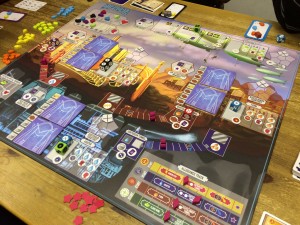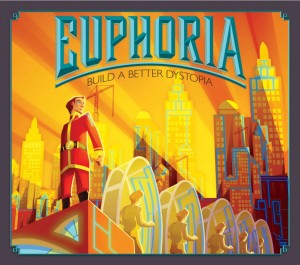Thoughts on: Euphoria with Two Players
Posted by James (admin) on February 6th, 2014
 After playing Euphoria as a 2-player game, I thought I would post some more detailed thoughts about it as there seems to be a fair amount of interest in how it plays with two. This is really a post for those whom know how Euphoria is played as it goes into detail about the rules and assumes knowledge of them. (To find out more about Euphoria, you can read my main review.)
After playing Euphoria as a 2-player game, I thought I would post some more detailed thoughts about it as there seems to be a fair amount of interest in how it plays with two. This is really a post for those whom know how Euphoria is played as it goes into detail about the rules and assumes knowledge of them. (To find out more about Euphoria, you can read my main review.)
PLAYING WITH 2 PLAYERS
When played with 2 players, Euphoria is played almost the same way as with more players with just 2 rules differences: First, there are only spaces for 2 stars in each territory. Second, it takes only 2 actions to build each market which means markets are built very quickly and we soon had all 6 complete. We both built markets that we knew our opponent could not assist in before they were completed. As a result, we were both soon playing with 3 restrictions each (although I paid one off later). I didn’t mind this at all as it made for some interesting choices and gave us both a different perspective of the board.
As with 5 players, I enjoyed playing Euphoria with 2 players – the theme works really well with the game mechanics and I like the constant decisions involved; however, I did find it gave a slightly different experience compared to when played with more players. The key reason for this is that some of the game mechanics feel a bit more subdued than when played with more players, such as the development of the allegiance and tunnel tracks which add an interesting element to the game. Also, with fewer players there is less chance of your workers being bounced back to you and less chance of higher totals when earning commodities. I’ll discuss these items in more detail below along with some suggestions as to how I think a few rules changes may address these.
SUGGESTIONS FOR 2 PLAYERS
Note that the following are suggestions and have not been play-tested.

Allegiance Tracks and Tunnels
The biggest difference with the 2 player game was that it can take much longer to progress the allegiance tracks and the tunnels. During my 2-player game, no tunnels and only 1 allegiance track got completed.
Without these being developed, it can take ages to activate your second recruit if you’re the only player with a recruit of that colour – this means the allegiance benefits and the extra action space (from a completed tunnel) are not available. (It was just unfortunate in my 2-player game, but I had a recruit whose special ability was useless by the time I was eventually able to activate him because his ability was linked to building markets which had long since been built.)
Developing the tracks and tunnel makes quite a difference to the game so I’d try reducing the number of spaces on these tracks so the allegiance benefits, activation of second recruits, stars that get placed on recruits, and bonus actions from tunnels happen sooner in the game like they do when played with more players. I’d try removing 3 spaces from each allegiance track [1 from each of the 3 big sub-sections] and remove 2 spaces off of the tunnel tracks [one before and one after the recruit activation]. (That may be too many but it’s a starting point.)
The Two Starting Recruits
With 2-players, I would also make it so that a player is not allowed to have 2 recruits of the same colour. The problem with this is that it incentivises the player to focus on developing just the one matching allegiance track because it allows them to (a) place 2 stars on the recruits when just one track is completed, and (b) they get to activate their second recruit whilst achieving this too. Meanwhile, an opponent with 2 different coloured recruits that do not match their opponent’s colour has to develop two tracks on their own to achieve the same effect which is much harder and takes much longer.
I understand that a player with 2 different colour recruits gets the benefits from two different allegiance tracks (and a player with a pair of same coloured recruits only gets the benefits from one). However, a player only gets the benefit of the second allegiance track when the second recruit’s allegiance track (or the relevant tunnel) is developed enough to activate them, and time spent developing that means less time spent developing their first recruit’s allegiance track in order to gain and use its own benefits. (With more players, having two different colour recruits is less of an issue because multiple players are usually developing tracks that they share with other players.)
[Note that it’s only when one player has two recruits of the same colour and the other does not that I think this is out of balance. If both players in a 2-player game have the same two colours of recruits (i.e. red/blue and red/blue), or if they have one colour in common and one unique (i.e. red/blue and red/green), then these should work fine because their interest in developing tracks is balanced.]
Bumping Workers
With fewer workers in the game, there is less chance of having a worker bumped back to you. This removed some of the reason for having extra workers because their free return was a good benefit as it reduces the number of turns used to recall workers.
It could be said that having 3 or 4 workers automatically means less turns spent recalling them; however, bringing them all back in one turn is risky due to the high chances that they’ll have too much knowledge and run away. Therefore, I only recalled 2 or 3 workers at a time (like in my game with more players) and the others were left on the board but, with 2 players, they had a lower chance of being bumped back to me.
This situation is the same for both players but I felt the strategic option of spending time and resources to have more workers versus not doing that was reduced with 2 players because the benefit of more workers was less.
To address this, I would like to try a system where players turn over one recruitment card from the deck at the end of each round and any players on temporary action spaces in the matching territory get bumped back to their owners. This makes it more likely for the workers to be bumped back. Plus, it also restores some of the ‘danger’ when owning lots of workers because they can get bumped back to you at an inconvenient moment when you have lots of unplaced workers who already have a dangerous amount of knowledge.
FINALLY
Overall, the 2-player game plays fine and still offers interesting decisions – it just has a slightly different feel to when it’s played with more players. With 2 players, the gain and use of resources seems to be at the same pace as a 5-player game whilst the allegiance and tunnel tracks develop more slowly, and this results in some of the game mechanics feeling more subdued or less important when played.
With a few rules tweaks, I think the 2-player experience could have more of the feel of the game when played with more players. As it stands, there are other worker placement games I would choose to play with 2 players before Euphoria but, as I mentioned in my main review, I really liked Euphoria’s gameplay and experience with 5 players and would like to play it more with 4-6 players.
James.


February 6th, 2014 at 3:13 pm
Lots of neat ideas here! One that I never considered–and is quite creative–is this: “players turn over one recruitment card from the deck at the end of each round and any players on temporary action spaces in the matching territory get bumped back to their owners.” I’m going to have to try that sometime. The one big downside to it is that I think Euphoria works best when it doesn’t feel like there are rounds, so this would get in the way of that, but maybe it would work with 2 players.